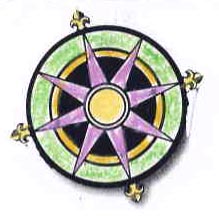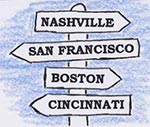|

This story was published in Radio Recall, the journal of the Metropolitan Washington Old-Time Radio Club, published six times per year.
Click here to return to the index of selected articles.
|
|
 CITIES OF ORIGIN: CITIES OF ORIGIN:
Identifying the sites of our Ethereal Experiences
by Jim Cox © 2007
(From Radio Recall, August 2007)
Ever since the golden age I've recognized that New York, Los Angeles and Chicago impressively dominated all U. S. cities that originated network radio programming. The trio possibly accounted for 95 percent of what we heard then and what we are privileged to hear now, thanks to electronics.
At the same time-and for a long while-I've harbored the conviction that there were lots of other places in America from which we reaped a comparative handful of some of our most treasured ethereal wares. Aside from those spots that hosted occasional sporting events, or provided temporary venues for big bands, or were fleeting pickup points for network newscasts, there were plenty of locations that generated performances of a persistent nature. Although I make no claim to an exhaustive list, it didn't take long to turn up more than two dozen metropolitan areas and townships from which major network and syndicated features emanated beyond New York, Los Angeles, Chicago and their environs.
Interestingly, the predominant form of programming broadcast from those venues was classical, semi-classical, pop and opera music-generally the highbrow type. In at least half of those cities of origin, contributions were partially or totally focused on one or more civic symphonies, philharmonic orchestras, or an educational institution's instrumental ensemble. Included were sites like Boston, Buffalo, Cincinnati, Cleveland, Detroit, Indianapolis, Oklahoma City, Philadelphia, Pittsburgh, Rochester, St. Louis and San Francisco, all of which trumpeted refinement of the highest levels of beats and strings in the 1930s and 1940s.
Beyond that impressive leader, a second category that showcased a lot of talent was those places originating country music jamborees and-frequently-their artists, independently starring in their own personality-driven hillbilly hoedowns. While there were up to three dozen such romps at any one time aircasting locally and sometimes regionally, often on powerful high-wattage stations that proffered widespread reach, a handful of those programs performed durably for network audiences.
The most influential-then and now-was Nashville's Grand Old Opry which commandeered an NBC half-hour every week for 18 years. The “mother church of country music” possibly spawned a score of chain-fed and syndicated shows beyond the Opry, many of them headlined by some of the breed's stalwarts (Roy Acuff, Eddy Arnold, T. Tommy Cutrer, The Duke of Paducah, Jim Reeves, Ernest Tubb and Leroy Van Dyke).
Others of the ilk with national platforms were Charlotte's Carolina Hayride (which also produced a string of related talents like Grady Cole, Larry Walker and the Johnson Family Singers, Arthur Smith and the Crackerjacks); the Renfro Valley (Kentucky) Barn Dance (prompting multiple series, including CBS's enduring Renfro Valley Sunday Mornin' Gatherin'); Richmond, Virginia's Sunshine Sue (a celebrity from the local Old Dominion Barn Dance); Springfield (Missouri's) Ozark Jubilee; and Wheeling (West Virginia's) Jamboree USA. In addition, in the early 1950s on a rotating basis, CBS's Saturday Night Country Style devoted 30-minute pickups to a half-dozen of the remaining local and regional shindigs scattered throughout the nation like Shreveport's Louisiana Hayride.
Aside from the hymn-singing inspired by multiple country music venues, religion filled a prominent niche in America's national radio programming. With Shreveport tendering The Baptist Hour, Minneapolis became the base for Billy Graham's Hour of Decision. St. Louis generated The Lutheran Hour as Music and the Spoken Word from the Crossroads of the West was beamed from the Mormon Tabernacle in Salt Lake City.
 Not surprisingly, the radio fare coming out of Washington, D. C. was focused almost altogether on government-related issues. A few prominent series titled Washington Merry-Go-Round, Congress Speaks and Capitol Cloakroom dominated that talkathon scene. Not surprisingly, the radio fare coming out of Washington, D. C. was focused almost altogether on government-related issues. A few prominent series titled Washington Merry-Go-Round, Congress Speaks and Capitol Cloakroom dominated that talkathon scene.
Amazingly, dramatic fare wasn't the exclusive property of programming emanating from New York, Los Angeles and Chicago. Detroit nurtured a healthy respect for adventure tales: The Lone Ranger, The Green Hornet, Sergeant Preston of the Yukon, Silver Eagle-Mountie, et al. Narratives caught on in Cincinnati in the form of The Life of Mary Sothern, Famous Jury Trials, Midstream-and “the mother of the airwaves” spent her incubation period there before Ma Perkins was dispatched to Chicago and NBC. Kansas City got in on the act with Happy Hollow; it was also the place that produced Easy Aces in its pre-web fabrication. San Francisco initiated a whole lot of early dramatic fare, too; One Man's Family is doubtlessly certified as its most imposing yarn.
Finally, there was a mixture of every other strain. While Austin (Minnesota) was giving us the Hormel All-Girl Band, Cincinnati produced Plantation Party, Avalon Time (introducing comedian Red Skelton) and a couple of hits with juveniles-No School Today and Big Jon and Sparky (the same show, incidentally, although one appeared on Saturday and the other on weekdays). Honolulu enchanted us with Hawaii Calls; Nashville tuned up for an orchestral Sunday Down South; Bing Crosby crooned at the City by the Bay, San Francisco, on Philco Radio Time; and St. Louis aired-what else?-the St. Louis Blues.
Somewhat astonishingly, I was never able to pinpoint a national series that originated in Atlanta and New Orleans-a couple of cities that I feel sure belong on this list. Provided such programming existed, it surely went under obscure or unrelated monikers to its places of origin.
And what I did learn from this research? Confirmation that even stations in the hinterlands were sharing some of their best efforts with all of us during radio's golden age. Although New York, Los Angeles and Chicago, like magnets, drew most of their talent from the heart of the nation, there were still homespun venues and performers that remained geographically closer to the vast majority of their audiences, exhibiting artistry in some of the nation's innermost locations.
|